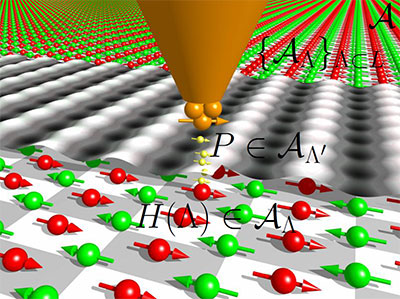Algebraic Formulation Quantum Dynamics
The investigation of single magnetic atoms and magnetic clusters with a spin-polarized scanning tunneling microscope (SP-STM) raises the necessity of a quantum mechanical description of spin systems. The components of a spin, whose expectation values can be measured with an SP-STM, can be represented as elements of a local  -algebra
-algebra  .
.
The algebraic approach to Quantum Statistical Mechanics provides mathematically highly developed tools for a deep and fine analysis of physical systems. Within this framework quantum spin systems are modeled via a  -algebra
-algebra  with a net
with a net  of
of  -subalgebras.
-subalgebras.

FIG. 1: The tip of the SP-STM induces a perturbation  of a nite system or a bouned derivation
of a nite system or a bouned derivation  for the innite case.
for the innite case.
We are intereseted in applications of those mathematical tools to real systems, which are experimentally investigated with a SP-STM. Therefore we distinguish between a free unperturbed system  with Hamiltonian H (e.g. magnetic atoms) and a perturbed system
with Hamiltonian H (e.g. magnetic atoms) and a perturbed system  with Hamiltonian
with Hamiltonian  (e.g. magnetic atoms plus SP-STM tip) depending on the situation if there is a perturbation
(e.g. magnetic atoms plus SP-STM tip) depending on the situation if there is a perturbation  induced trough the interaction between the tip and the sample or not. The finite temperature is considered in the free unperturbed or perturbed Kubo-Martin-Schwinger (KMS)-state
induced trough the interaction between the tip and the sample or not. The finite temperature is considered in the free unperturbed or perturbed Kubo-Martin-Schwinger (KMS)-state  or
or  characterizing the unperturbed or perturbed thermal equilibrium. The dynamics is given by the Heisenberg relations and described through a free unperturbed or perturbed one-parametric group of *-automorphisms
characterizing the unperturbed or perturbed thermal equilibrium. The dynamics is given by the Heisenberg relations and described through a free unperturbed or perturbed one-parametric group of *-automorphisms  or
or  acting on
acting on  . Depending on the physical situation the functions
. Depending on the physical situation the functions

are applied. For the numerical calculations a self-developed computer program is used.
The abstract mathematical foundations can be found in the books Operator Algebras and Quantum Statistical Mechanics I+II.
